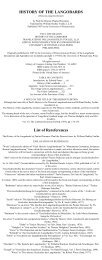Thule Italia estate2006.indd - thule-italia.org
Thule Italia estate2006.indd - thule-italia.org
Thule Italia estate2006.indd - thule-italia.org
You also want an ePaper? Increase the reach of your titles
YUMPU automatically turns print PDFs into web optimized ePapers that Google loves.
Book review by<br />
Prof. Manuel Sarkisyanz<br />
Hitler,Buddha, Krishna<br />
esoteric Fascism (p. 463) came about by Fascist imitations<br />
of Tantric categories of Vitalism and Power - which in<br />
themselves had been inherent in Nazi sentiment (not<br />
without impacts from Bavarian folk-vitalism). Even the<br />
famous [Fascist] Tibetologist’s, Tucci’s rhapsodies about<br />
“heroic Buddhism” (p. 193) cannot be accepted uncritically<br />
-just as War Sermons (usually on the text of Christ bringing<br />
not Peace but the Sword) could never characterize<br />
Christianity as a whole. (Logically Fascists have rejected its<br />
message while emulating its institution: the Church with<br />
its Hierarchy and Discipline.) Obviously the SS’s-film about<br />
its expedition to the Dalai Lama’s realm (pp. 155f ) showed<br />
only what its chief desired to be seen -just as the exiled<br />
14th Dalai Lama’s Buddhist messages to the democratic<br />
world leave out what has been undemocratic in Lamaism.<br />
T 0 such present day uncritically unilateral images of<br />
exclusively humanitarian and pacifist Tibet this book is a<br />
most healthy corrective. Thus the authors point out that a<br />
public discussion about the Buddhist Tantrism of Tibet by<br />
the Dalai Lama would prevent its misuse and distortion by<br />
SS esoterics. But they can be easily misunderstood to the<br />
effect that there was nothing humanitarian and nothing<br />
pacifical about the Dalai Lama’s realm, considering that<br />
among his friends was the SS auxiliary Jean Marquès<br />
Rivière as well as Guru Shoko Asahara who (in 1995)<br />
caused poison gas injury to more than 5000 victims in<br />
the Tokyo subway -as sacrifice to Shiva Rudra-Chakrin,<br />
apocalyptic world ruler in the Kâlachakra Tantra (pp.<br />
505, 518). Such an “Aryan Priest-King” of post-war Nazi<br />
mysticism (p. 469f ) -and not the specifically Buddhist<br />
universal ruler (Chakkavattî) is rightly compared with the<br />
Japanese Tenno -and wrongly with the ideal Buddhist<br />
emperor Ashoka of the third century B. C. (pp. 469f ).<br />
Most absurdly, Himmler’s indologist Wüst and the Fascist<br />
Baron Evola as well as protagonists of postwar SS mysticism<br />
saw precisely in Ashoka the great power political model...<br />
of “the Aryan Priest-King”. Their absurdities about Ashoka<br />
should have been contradicted most definitely. After all,<br />
he recorded his unf<strong>org</strong>ettable regret even about “one<br />
thousandth part of those who were slain”. “And this has<br />
been recorded in order that... whoever they may be, may<br />
not think of new conquests as worth achieving... through<br />
arrows.” And that the only “real conquest is a Conquest<br />
through Dhamma [force of MoralitY1.” Ashoka’s pride<br />
was that he “achieved conquest through Dhamma ,... a<br />
conquest flavoured with love” (7). And yet, with Ashoka<br />
remaining unmentioned in the context of oriental ideals of<br />
universal empire, the Chakkavattî/Chakravartin (prototype<br />
of Buddhist kingship) appears under the subtitle<br />
“Apotheosis of the Führer” (p. 328). Among the numerous<br />
references to this Indian embodiment of absolute power<br />
remains unmentioned the Chakkavattî-Sutta, one of the<br />
earliest Buddhist texts, starting that to the Chakkavattî<br />
the East, South, West and North shall submit voluntary:<br />
He shall declare that no living being is to be injured. (8)<br />
In contrast, the Chakravartin meant by the authors is<br />
Kalki from the Brahmanic Vishnu Purana (with reference<br />
to whom concludes Evola’s “Revolt against Modernity”),<br />
Aryan world ruler, symbolized by the Swastika (p. 256).<br />
In reality, Kalki in India and the Chakravartin in Buddhist<br />
Burma had inspired politically opposite phenomena too:<br />
It was precisely from Kalki that same Pariah groups<br />
expected their emancipation against the caste hierarchy.<br />
In same rural areas Gandhi was identified with such a<br />
future incarnation of Vishnu. About the Chakkavattî Sutta’s<br />
description of the ideal future state reminded in 1959 U<br />
Nu (Burma’s Prime Minister 1947-1958 and 1960-1962) -<br />
with reference to his anti-imperialist Buddhist socialism.<br />
(9) In the name of the Chakkavattî (Burmanized as “Setkya<br />
Min”) repeatedly revolted Burma’s peasants (as recorder<br />
after 1837). With this ideal Buddhist ruler was identified<br />
the central figure of the Burmese Peasant War of 1930-<br />
1932. (10)<br />
This shows how much more correctly than by Fascist<br />
indologists and their subsequent esoterics was<br />
Buddhism understood by Hitler’s inspirer, Houston<br />
Stewart Chamberlain, and the Führer’s rival Ludendorff.<br />
Chamberlain saw that Buddhism “was moved by<br />
humanitarian reverie, proclaiming the equality of all human<br />
beings” (10a). Ludendorff reminded that it “preached selfextinction...,<br />
spiritual and bodily disarmament” (p. 295),<br />
both comprehending its ethos better than Himmler’s<br />
Professor Wüst and Mussolini’s Baron Evola. A “Duce from<br />
Bengal” can be seen in Subhas Chandra Bose (pp. 93) only<br />
disregarding that a Soviet alliance would have been his<br />
first choice: As vanished Redeemer he “is biding his time...<br />
Millions of Indians believe... he is hiding in Moscow, being<br />
instructed in the principles of revolution... Eagerly they<br />
await[ed] him...” (11)<br />
And archetypically less remotely from Communism than<br />
from Fascism led historically that “Gnosis”, Satanizations of<br />
which are inherited in Political Science since Eric Voegelin<br />
(and echoed on p. 537): By “Gnosis” is usually meant its<br />
Manichean current. In fact, its vision of all material world,<br />
with all established institutions, being in the power<br />
of Evil, stimulated revolt rather than conservation of<br />
the established order. And that class distinctions and<br />
hierarchies have no meaning at all for the truly Initiated<br />
is among the messages of the Bhagavad Gita too: In the<br />
Brahman and in the [despised] cook of dog meat the wise<br />
ones behold the same. Already here [on earth] is Heaven<br />
won by those whose mind rests upon this Equality... That<br />
they are rich and noble think those blinded by ignorance.<br />
(12)<br />
That the SS Chief invoked one passage from this is no more a reflection upon this scripture (that<br />
was being invoked again and again by India’s social<br />
reformers -not only in pacifist Gandhism (13) but also in<br />
“Hinduized Communism” (14) than the “socialist” name<br />
of Hitler’s party is a reflection upon Socialism. It was<br />
not so much that Savitri Devi found in the Bhagavad<br />
Gita principles that lend themselves for a convincing<br />
integration into SS ideology (p. 360); it was rather that she<br />
insisted on having found them: Her conclusions are not<br />
covered by the texts she quoted (p.357), about fulfilling<br />
duty without regard for the outcome, about a just fight,<br />
about Heaven for the fallen warriors and the Earth for the<br />
victorious ones. Actually, the texts this “Priestess of Hitler”<br />
emphasized lend themselves in general to hopeless,<br />
heroic resistance against powers of this world, resistance<br />
that has been much less offered by Fascists (under whom<br />
the weak had no claim to survival) than by anti-Fascists<br />
with their faith in a world that shall belong to the weak.<br />
(15)<br />
On the other hand, not to every Professor is given the<br />
character of professinq convictions: Thus it is more the<br />
adjustment of certain German indologists to financial<br />
incentives offered by 88 institutions than “affinities” of<br />
the Gita and of Buddhism to Fascism that is proved by 88<br />
appropriations of “Oriental” thought.<br />
The weakest text in the book might be that “a Buddhist<br />
dissolves his Ego for the ‘Liberation’ of all suffering beings<br />
and a National Socialist for , but this<br />
could again and again in the history of Buddhism mean<br />
the precept of killing out of compassion and wisdom”(p.<br />
458).<br />
SOURCE REFERENCES<br />
1) Jean-Michael Angebert, The Occult and the Third<br />
Reich (New York, 1974); François Ribadeau Dumas, Hitler<br />
et la sorcellerie (Paris, 1975); RR Carmin, “Guru” Hitler, Die<br />
Geburt des Nationalsozialismus aus dem Geist von Mystik<br />
und Magie (Zürich, 1985); Jean Robin, Hitler, I’élu du<br />
dragon (Paris, 1987)<br />
2) Hitler’s speech of 28. April 1939: Deutscher<br />
Kurzwellensender; Hitler, Monologe im<br />
Führerhauptquartier, edit. W. Jochmann (Hamburg, 1980),<br />
pp. 48, 62 f.; W. Maser, Das Regime. Alltag 1933-1945<br />
(Manchen, 1983), p. 259; J.H. Voigt, „Hitler und Indien“:<br />
Vierteljahreshefte für Zeitgeschichte, IX (1971), pp. 33, 49<br />
3) Hitler, Speech of 22. August 1939 to the supreme<br />
commanders; L.P. Lochner, What about Germany? (New<br />
York, 1942), p. 3<br />
4) Gerwin Strobl, The Germanic Isle. Nazi perceptions of<br />
Britain (Cambridge, 2000), pp. 41, 42<br />
5) Heinrich Himmler, Geheimreden und andere Ansprachen<br />
(Frankfurt, 1974), p. 159: Speech of 9th. June 1942<br />
5a). Hannah Arendt, Elemente und Ursprünge totaler<br />
Herrschaft (Frankfurt, 1955), pp. 307, 313<br />
5A). S.B. Dasgupta, An introduction to Tantric Buddhism<br />
(Calcutta, 1958), p. 179 f; John Blofeld, The Way of Power<br />
(London, 1970)<br />
5B) “Die Linke ausgeschaltet, Osterreich eingeschaltet,<br />
die Massenmedien gleichgeschaltet, Deutschland isoliert,<br />
ganz Europa in Spannung versetzt und schließlich den<br />
Kurzschluss erzeugt.“<br />
6) Helmut Hoffmann, Die Religionen Tibets (Freiburg B,<br />
1956), p. 58 ff., 119 f., 163; Hoffmann, „Das Kâlachakra, die<br />
letzte Phase des Buddhismus in Indien“: Saeculum, XV/2<br />
(1964), p. 128<br />
7) Ashoka‘s 13th Rock Edict: D.R Bhandarkar, Asoka<br />
(Calcutta 1925), pp. 300-303; J. Bloch, Les inscriptions<br />
d‘Asoka (Paris, 1950), pp. 125-132<br />
8) Cakkavatti-Sîhanâda-Sutta, Diaha Nikâva, XXVI, 6:<br />
Translation by Rhys Davids, Sacred Books of the East, IV<br />
(London, 1957), p. 63f<br />
Monier-Williams, Brahmanism and Hinduism. (London,<br />
1889), p. 114; Bharatan Kumarappa, introduction to: M.K.<br />
Gandhi, Hindu Dharma (Ahmedabad, 1950), p. VIII; U Nu’s<br />
Speech of November 16th, 1959 before the Anti-Fascist<br />
People’s Freedom League (Burmese typescript given by U<br />
Nu to the author), pp. 17f, largely reprinted in Bama-hkit of<br />
17. XI 1959, p. 8; Sarkisyanz, Buddhist Backgrounds of the<br />
Burmese Revolution (The Hague, 1965), p. 224<br />
10) Cf. Maurice Collis, Trials in Burma (London, 1938), pp.<br />
129, 273f.<br />
10a) Houston Stewart Chamberlain, Briefwechsel mit<br />
Kaiser Wilhelm II (Munich, 1929), Vol. 11 p.152<br />
11) J. A. Michener, Voice of Asia (New York, 1952), p. 265;<br />
of. NA Chadhuri, “Subhas Chandra Bhose, his legacy and<br />
legend”: Pacific Affairs (1955), p. 356. All italics are mine.


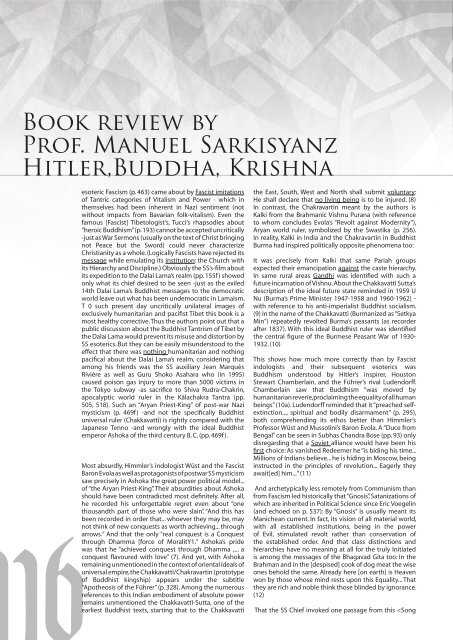
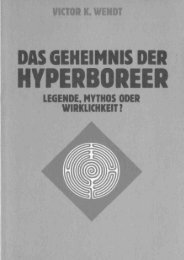
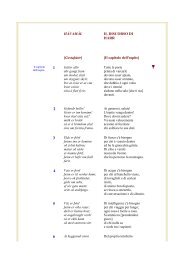

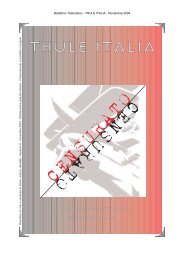
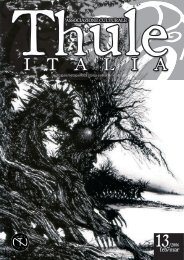


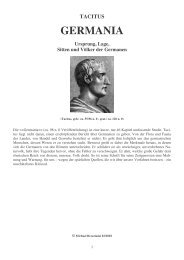
![Götter, Dämonen und Gewissen [1938]](https://img.yumpu.com/3417736/1/163x260/gotter-damonen-und-gewissen-1938.jpg?quality=85)
